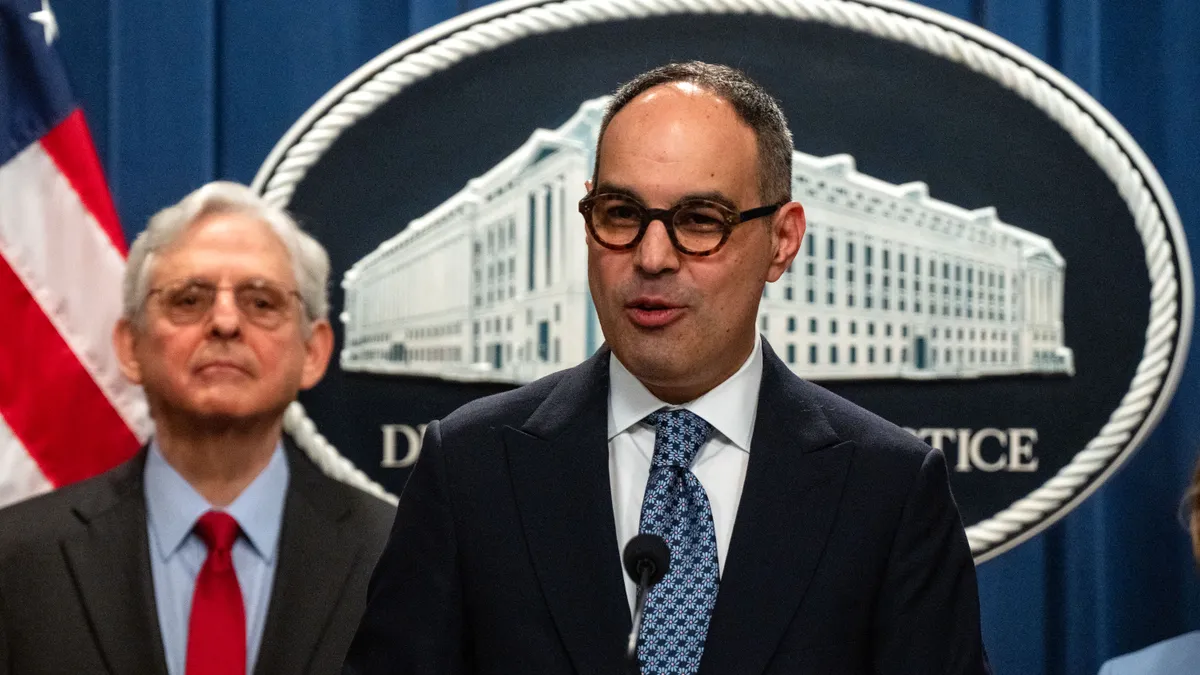Banks and bank trade groups have come out mainly shooting at the Federal Reserve Bank’s report earlier this year on the possibility of creating a central bank digital currency (CBDC).
In public comments filed with the Fed, they contended a CBDC, as currently envisioned, wouldn’t provide enough benefits to justify the risks, could injure the existing financial system, sap deposits from banks and increase the likelihood of a bank run during a crisis event.
Aside from those criticisms, many said in the May comments that the report just doesn’t offer enough detail about the design of a CBDC to give substantive feedback about how one might be implemented. Their comments echo those of some major payments companies.
Their feedback came in reaction to the Fed’s 40-page report on the potential for a CBDC issued in January and suggesting possible ways a CBDC could enhance the current U.S. payments system, but also voicing concerns about the idea. While exploring the possibility of issuing a CBDC, the Fed didn’t take a position on whether it would pursue any such plan. As Fed officials have commented publicly on the issue, they’ve taken varying positions.
Many countries are racing ahead with issuing, piloting or making plans for their own digital currencies as the world embraces the concept of moving money in electronic form. Nonetheless, the bank actors repeatedly pointed out that the private sector is making so much headway on that front that the notion of a CBDC may be duplicative.
The Fed received input from dozens of companies, trade groups and consumer advocacy organizations before its May deadline, but little has been written about their views. The central bank promised to take their feedback into consideration as it assesses how best to preserve the dollar as the global reserve currency.
Below are some highlights from the many pages of commentary provided by JPMorgan Chase, State Street, the Independent Community Bankers of America, the American Bankers Association, Credit Union National Association and the Bank Policy Institute.
JPMorgan Chase
While the biggest U.S. bank tried to be measured in its comments, avoiding the more dramatic comments of some bank interests, it mainly cast doubt on the possibility of reaping any benefit from a CBDC as presented in the Fed’s report, and highlighted the potential for risks. Although the bank said it agreed with the Fed’s goals of broadening inclusion in the financial system and improving cross-border payments, it took issue with the likelihood of a CBDC accomplishing those goals without harm to the existing financial system.
“As the FRB acknowledges, the introduction of a CBDC could introduce significant new risks to the U.S. financial system,” the bank said in its May 20 response to the Fed. “Consequently, the introduction of a CBDC should be approached with caution and supported by clear evidence that it will further these policy objectives without the introduction of undue costs or excessive risks.”
New York-based JPMorgan stressed that many private programs underway address some of the inadequacies of the current U.S. payment system, pointing to its own recent development of the blockchain-based JPM Coin designed to create a more efficient approach to cross-border payments for its corporate clients.
The bank also noted The Clearing House’s real-time payments services and the instant payment system Zelle, both of which are backed by major U.S. banks, as well as the soon-to-be launched Federal Reserve public alternative to that system, FedNow. On the cross-border front, the bank also noted advances at the Society for Worldwide Interbank Financial Telecommunication (Swift), the Belgium-based global financial messaging service.
“Recent progress makes it clear that a CBDC is not critical to improving the speed of payments or addressing existing concerns with domestic and crossborder payments,” JPMorgan said in its 21-page commentary.
Aside from that sentiment, the bank raised concerns about risks, including the reduction of bank deposits, bank runs in times of stress, more costly credit services, potential cyber incursions, higher banking costs, consumer privacy shortcomings and a more challenging environment for the Fed’s own monetary policy.
Ultimately the bank concluded that it “remains concerned about these risks especially when weighed against existing evidence of the benefits a CBDC would provide.”
State Street
For its part, Boston-based State Street bank flagged the risks of implementing a CBDC and praised the Fed for taking a slow and cautious approach to the idea.
“The implications of a CBDC for the US financial system are vast and complex, and include the potential disruption of existing bank funding models, the disintermediation of key components of the short-term funding markets, such as money market funds and commercial paper, and the potential for greater susceptibility of the system to financial stability risk,” State Street said in its May 20 letter.
The bank sought to limit the implementation of any CBDC, saying it should be confined to the wholesale market if it’s launched as a way of testing the idea. The bank suggested that the more limited approach would help alleviate any disruption to the current financial system and reduce the risks of implementing the innovation.
“State Street believes that efforts to understand and deploy the transformative implications of a US CBDC are best supported by initial work on narrower focused CBDC solutions designed to address existing inefficiencies in the wholesale market,” said the letter written by Joseph Barry, senior vice president and global head of regulatory, industry and government affairs at the bank. “In particular, we recommend that the Board prioritize efforts to develop and implement CBDC functionality for the inter-bank payment system, both domestic and cross-border, which can then be leveraged over time to address other promising use cases.”
Banking trade groups
The U.S. banking trade groups largely echoed their bank members, though were in some cases more alarmist in their comments, underscoring the damage that could be done if the Fed’s experiment with a CBDC creates havoc for the existing financial system. They were also less open to testing the idea or reserving judgment until the Fed is able to provide more information on its design.
“As we have evaluated the likely impacts of issuing a CBDC it has become clear that the purported benefits of a CBDC are uncertain and unlikely to be realized, while the costs are real and acute,” the American Bankers Association said in its 24-page commentary. “Based on this analysis, we do not see a compelling case for a CBDC in the United States today.”
The association concluded that a CBDC should be pursued only if the goals of the project can’t be met through other payments system innovations.
The Independent Community Bankers of America organization took an even stronger stance opposing a CBDC, stressing the downside of such a move.
“After careful consultation with community bankers, ICBA opposes a CBDC because the creation of a CBDC will introduce significant privacy and cybersecurity risks into the nation’s monetary system and disrupt the stability of America’s banking system,” the organization said in its May 20 response. “A CBDC could threaten the health of the U.S. financial system by destabilizing existing banking and payments systems that are the backbone of our economy and markets.”
Aside from those risks, the organization cast doubt on a CBDC achieving any of the Fed’s stated goals, such as improving the efficiency of the payments system, drawing more of the unbanked into the financial system and improving cross-border money transfers. Under a heading that said a CBDC would “damage” the existing financial system, the ICBA said: “If the Federal Reserve issues a CBDC it will cause significant disruptions in the financial system, potentially leading to permanently tightened credit conditions and institutional failures.”
In addition, the organization noted that it doesn’t believe the Fed has the authority to pursue a CBDC and cautioned it against making a move in that direction without authorization from Congress.
“ICBA’s position is that the Federal Reserve should not issue a CBDC because the associated risks would outweigh any potential benefits,” the group concluded in its 19-page letter.
The Credit Union National Association was similarly skeptical of the benefits a CBDC would bring the existing payments and financial services system.
“We have concerns, however, that under several scenarios the creation of a CBDC could significantly worsen the provision of financial services,” wrote Madison Rose, CUNA’s director of advocacy and counsel for payments and technology. “While there are no doubt opportunities for improvement, we believe most, if not all, can be addressed by innovations in the current financial services framework and through continued public-private partnerships, without the introduction of a novel digital currency that could destabilize the system.”



















